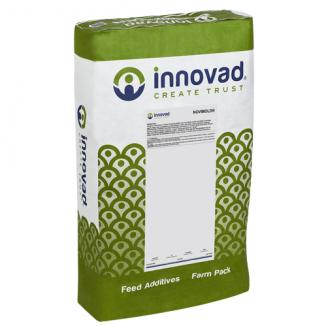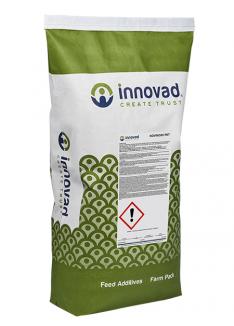Feed Preservation
Maintaining feed quality
Feed quality is a key issue in animal performance and contributes to the profitability. Both microbiological and chemical processes within feed and feed raw materials will alter its nutritional value and contaminate the feed with hazardous molecules. Feed of high quality can be defined as a well-balanced diet, with correct levels of macro- and micro nutrients, highly digestible proteins, high digestible energy, including a number of beneficial additives and free of contaminants.
Based on HACCP-principles, contaminants can be divided in different groups: Chemical and microbiological contaminants. The group of microbiological contaminants is composed out of moulds, yeast and bacteria which might lead to nutrient spoilage and production of toxic compounds.
Innovad offers different products which contribute to a better basic feed quality, assuring longer shelf life and preserving nutritional quality and palatability.
Moulds consume valuable nutrients, make feed unpalatable and produce toxins
Mould spores are present within plant material and environment. Animal feed and raw materials provide the nutrients required for their development. Moisture content is critical for mould development, more specific the available water (Aw-value). The Aw-value expresses the amount of available water for microbial growth and should not exceed 0.6. Even moisture levels of 11-12% can result in an Aw-value higher than 0.6. Climate, harvest and storage conditions (e.g. condensation in silos) will have a significant impact on the Aw-value. Temperature and grain breakage are important factors which will mainly affect the rate of mould reproduction. Mould growth will have an important impact on feed quality. Losses on dry matter can go up to 20% (mainly energy and proteins) and mycotoxins, produced by moulds, will be detrimental to animal health and performance. Due to changes in physical properties, problems such as “crust formation” in silos might occur, as well as palatability issues.
Novimold is a complete range of specifically designed mould inhibitors. Selection can be based on level of active ingredients, buffered or non-buffered mixes, liquid or dry, application, corrosiveness, surface tension reduction etc.
Oxidative rancidity: an important feed quality issue
Autoxidation is a typical example of undesired chemical feed degradation. It is a destructive irreversible reaction which occurs in organic materials when exposed to oxygen. Oxidative rancidity is a complex chemical process that occurs in different phases (initiation, auto-oxidation and termination). It has a major impact on flavour, nutritional quality, and health of the feed product which are major concerns for feed manufacturers. Because of rancid flavour and change of colour and texture, the process of oxidation leads to a lower palatability and by consequence to a reduced feed acceptance by the pet. Vitamins, fats and proteins lose their important nutritional value and the aggressive molecules formed during the process are detrimental to the intestinal cell lines and beneficial bacteria.
Novinox is a selective range of antioxidant combinations.The selection of the product will depend on the type of material to be protected (feed- concentrate - premix - raw material - fatty acid profile); the application, the required shelf life and specific customer requirements (e.g. pet food).

